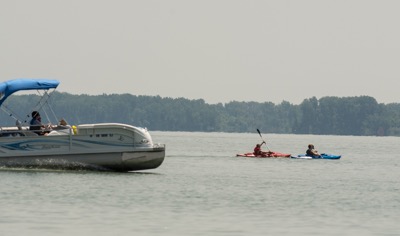Wednesday, July 29th, 2015
State raises lake algae advisory
By Kathy Thompson

Photo by Mark Pummell/The Daily Standard
A pontoon boat Tuesday afternoon cruises past two kayakers on Grand Lake along Lakeshore Drive in Celina. The state has issued a new public health advisory after high levels of microcystin toxins were detected in the lake.
CELINA - The state health department on Tuesday recommended the public have no contact with Grand Lake's water due to increased levels of microcystin toxin and a probable case of illness reported early last month.
The "elevated public health advisory" by the Ohio Department of Health warns all visitors and pets to avoid swimming and wading in the lake.
"We don't want people to be in the water," Dr. Mary DiOrio, the medical director for ODH, told The Daily Standard this morning.
She explained activities such as boating that can be done without contact with the water can continue.
According to ODH, a woman was Jet Skiing in the lake June 6 and later was treated by a doctor for a rash. The doctor could not determine if the rash was caused by lake water but told the state health agency it was "probable."
New, red advisory signs were posted Tuesday around the lake. However, they are different from the two the Ohio Department of Health and Ohio EPA use and promote on a website - a recreational public health advisory (posted the past seven years) and a no contact advisory - to inform the public of algal issues in waterways.
"The wording is different," DiOrio said, adding the new signs explain that a probable illness recently occurred due to contact with the lake's water. "We're using a new strategy that gives us flexibility for new situations."
DiOrio said Grand Lake's new "elevated" advisory is similar to the no contact advisory issued for the lake after a massive algal bloom in 2010.
"The same message is conveyed," she said.
A no contact advisory is issued when toxin levels exceed the recommended threshold and there are one or more probable cases of human illness or deaths due to algal blooms, according to Ohio EPA.
In 2010, eight human illnesses and three dog deaths were linked to the toxic Grand Lake water. Two probable and suspected human illnesses and one dog death were reported in 2011.
The no contact warning is meant for the general public, unlike a recreational advisory that addresses individuals who are elderly, very young or have compromised immune systems, Ohio EPA states.
Microcystin is a liver toxin produced by blue-green algae that can harm humans and animals. It can lead to skin rashes, and if swallowed, can cause nausea, diarrhea and vomiting.
A microcystin toxin reading of 6 parts per billion or higher triggers a recreational water advisory. The World Health Organization's guideline for banning recreational contact is 20 ppb.
The most recent microcystin test taken July 13 by Ohio EPA shows 63.4 ppb at the state campground beach; 66.4. ppb at West Beach; 82.2 ppb at East Beach; and 99.6 ppb at Windy Point Beach.
In July 2014, tests showed 37.5 ppb at the state campground beach, 43.5 ppb at West Beach, 43.2 ppb at East Beach and 50.4 ppb at Windy Point Beach.
Late last month readings were 67.3 ppb at the state campground beach, 50.7 ppb at West Beach, 57.8 ppb at East Beach and 65.4 ppb at Windy Point Beach.
"We know it shouldn't be that high (above 20 ppb) and we're doing everything we can to bring back a healthy lake," said Milt Miller, a leader in efforts to clean up the lake.
Miller has asked the state to revisit the protocol that determines when and what type of advisories should be posted.
"We've had the same protocol since 2009 and we've learned a lot since then," he said.
Miller said tests are taken along the shoreline where water is often more stagnant. He believes they also should be taken in the middle of the lake, he said.
Ohio EPA Director Craig Butler said this year's excessive rainfall could be causing the high levels of microcystin. The rains wash more phosphorus into the waterways, he said.
In the past five years the state has spent more than $25 million to improve the water quality in Grand Lake with the use of treatment trains, wetlands construction, drainage control devices, dredging and the removal of rough fish.
Anyone with questions and concerns about the latest advisory can call ODH between 8 a.m.-5 p.m. seven days per week at 866-800-1404.
- Reporter Nancy Allen contributed to this story.
